One of the first memories that come to my mind when I think about school is the professor saying out loud during an exam: “Be aware: read carefully the question before answering!”. It seems as they were hiding the solutions of all the problems in the middle of the few line of text followed by a couple of white raws of desperation. And all the time, when I was listening to this hated sentence, I was freaking out as a child in front of a black and creepy room of a ghosted house. Why I was so scared now? Why, all of the sudden, I was not able to understand what the text was saying as I was trying to decode a cryptic message sent from a Martian directly to my poor desk of a middle school in Italy. Why that day I didn’t remain in my warm bed drinking a lovely coffee instead of facing another challenge that life was throwing on my way? And in particular, why were all of us (pimply-faced kids) so scared to fail?
Only a couple of years later I understood the meaning of that sentence, why failing is so important in research, and why standing up again is the seed of new discoveries. I’m Francesco, 25 yo and ESR5 and in today’s blog, I would like to talk about the necessity of science to be extremely polite and to play with your nerves ad let you fail constantly.
The Ph.D. life is a roller coaster of win/fail processes. We are exploring new possibilities, we are testing new alternatives, new ways to understand better Mother Earth. Since the moment is new, there aren’t instructions or manuals to read. Of course, you can find plenty of pages full of literature that explain the process behind fermentation or chemical reactions. But, always there is a small or big possibility to fail, even if you are planning a set of experiments in the minimum details. Even if you made those experiments an infinite number of times, Science is there ready to kick your back and place you again in the “rookie’s pub”.

This is the most important part of the process. Not that I like to fail on a daily-based, let’s be clear. But failure is the most useful step to reach innovation. When you don’t succeed, you “create” a problem. Then two possibilities show up on your street: 1) act as nothing happen 2) ask yourself what was wrong and (fundamental) why. Avoiding the problem isn’t a step at all. The problem will act as a boomerang and come back sooner or later. Then, understanding the problem is the first step to solving it. Making the problem yours and being able to describe it in all its corners is the car that can carry you to fix it.
And here again, we are back to our lovely sentence: “Read carefully the question before answer”. Most of the time, the solution is only covered by a layer of fog, but is there, exactly in the field of problem you just meet. Surrounded by fog it is difficult for sure to find a solution. So you need tools, light, and maps to understand where are you and where to go. Thus, grab a pen and start drawing the border of the field. When you will finish drawing, look at it from a different perspective: it is time to change your point of view and this might help to understand what is going on. And if not, add a light in the field and ask someone else for an opinion. Most of the time, if you overthink to a point you will finish losing the general picture behind it. Last, but not least, try. Convert one of your hypotheses to a possible solution. Don’t try just for trying. Try with sense and with a solid base, because in this way if you will fail again you will know why.
Think, plan, try.
It’s only a matter of time to build the street that brings you from the failure to the final solution. In the end, when you will look back to your street all the problems and the failures will be only lego pieces that made (or will make) you a professional in your field.
And remember always that failure is unavoidable but not irreversible. The only time when we really fail is when we stop to try.


“I have not failed. I’ve just found 10,000 ways that won’t work.”
Thomas A. Edison




